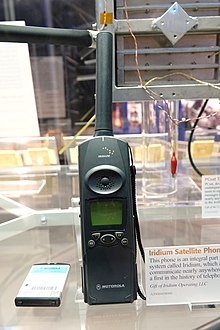 |
| Iridium satellite phone |
The Satellite Phone Wiki 2023 Edition will be updated throughout the year.
Sources and references include:
Wikipedia.org and Satellitemobilephones.com
From Wikipedia, the free encyclopedia
"A satellite telephone, satellite phone or satphone is a type of mobile phone that connects to other phones or the telephone network by radio link through satellites orbiting the Earth instead of terrestrial cell sites, as cellphones do. Therefore, they can work in most geographic locations on the Earth's surface, as long as open sky and the line-of-sight between the phone and the satellite are provided. Depending on the architecture of a particular system, coverage may include the entire Earth or only specific regions. Satellite phones provide similar functionality to terrestrial mobile telephones; voice calling, text messaging, and low-bandwidth Internet access are supported through most systems. The advantage of a satphone is that it can be used in such regions where local terrestrial communication infrastructures, such as landline and cellular networks, are not available.
Satphones are popular on expeditions into remote locations, hunting, fishing, maritime sector, humanitarian missions, business trips, and mining in hard-to-reach areas, where there is no reliable cellular service.[1] Satellite telephones rarely get disrupted by natural disasters on Earth or human actions such as war, so they have proven to be dependable communication tools in emergency situations, when the local communications system can be compromised.
Some satellite phone models use satellites in geostationary orbit (GSO), which appear at a fixed position in the sky. These systems can maintain near-continuous global coverage with only three or four satellites, reducing the launch costs. The satellites used for these systems are very heavy (about 5000 kg) and expensive to build and launch. The satellites orbit at an altitude of 35,786 kilometres (22,236 mi) above the Earth's surface; a noticeable delay is present while making a phone call or using data services due to the large distance from users. The amount of bandwidth available on these systems is substantially higher than that of the low Earth orbit (LEO) systems; all three active systems provide portable satellite Internet using laptop-sized terminals with speeds ranging from 60 to 512 kbit per second (kbps).
Geostationary satellite phones can only be used at lower latitudes, generally between 70 degrees north of the equator and 70 degrees south of the equator. At higher latitudes the satellite appears at such a low angle in the sky that radio frequency interference from terrestrial sources in the same frequency bands can interfere with the signal.
Another disadvantage of geostationary satellite systems is that in many areas—even where a large amount of open sky is present—the line-of-sight between the phone and the satellite is broken by obstacles such as steep hills and forest. The user will need to find an area with line-of-sight before using the phone. This is not the case with LEO services: even if the signal is blocked by an obstacle, one can wait a few minutes until another satellite passes overhead, but a GSO satellite may drop a call when line of sight is lost.
- ACeS: This former Indonesia-based small regional operator provided voice and data services in East Asia, South Asia, and Southeast Asia using a single satellite. It ceased operations in 2014.
- Inmarsat: The oldest satellite phone operator, a British company founded in 1979. It originally provided large fixed installations for ships, but has recently entered the market of hand-held phones in a joint venture with ACeS. The company operates eleven satellites. Coverage is available on most of the Earth, except polar regions.
- Thuraya: Established in 1997, United Arab Emirates-based Thuraya's satellites provide coverage across Europe, Africa, the Middle East, Asia and Australia.
- MSAT / SkyTerra: An American satellite-phone company that uses equipment similar to Inmarsat, but plans to launch a service using hand-held devices in the Americas similar to Thuraya's.
- Terrestar: Satellite-phone system for North America.
- ICO Global Communications: An American satellite-phone company which has launched a single geosynchronous satellite, not yet active."




No comments:
Post a Comment